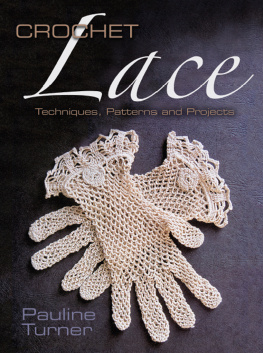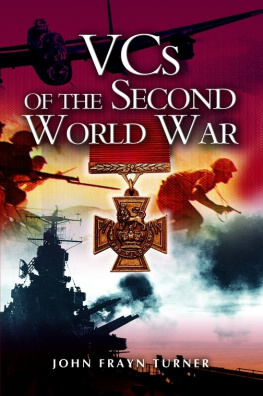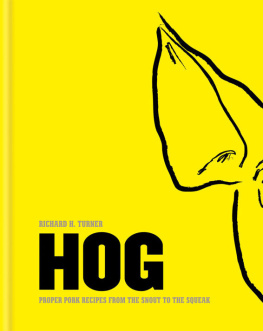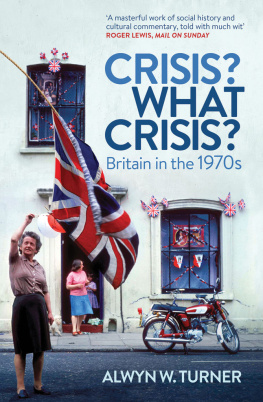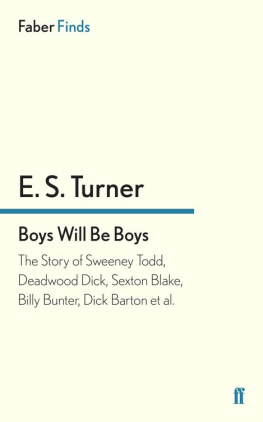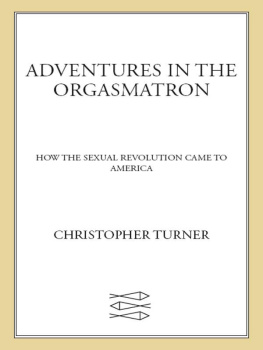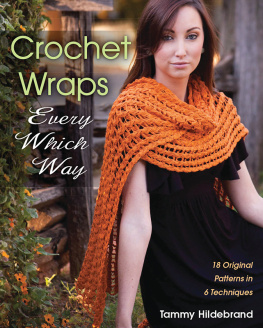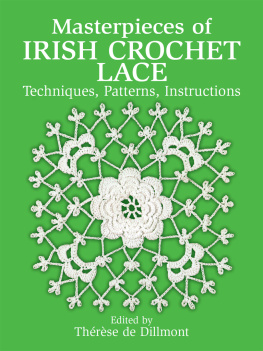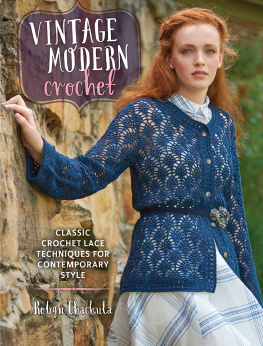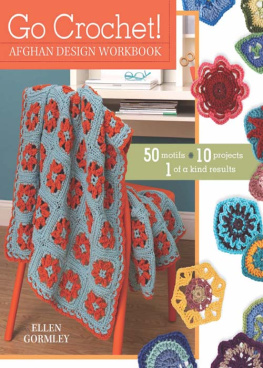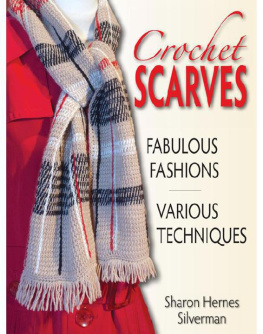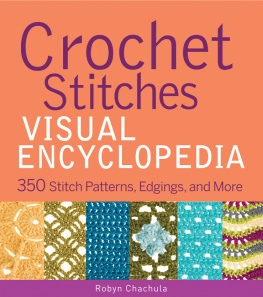CROCHET
Lace
CROCHET
Lace
Techniques, Patterns, and Projects
Pauline Turner
Dover Publications, Inc.
Mineola, New York
I would like to express my grateful thanks to Anita, Asa, Dorothy, Maureen, Rita, and Tracey. They were invaluable in encouraging and supporting me in this project.
Photographs: Syd Cumbus
Diagrams: Keith Aubrey
Additional crochet: Anita Shepherd, Dorothy Burton, Rita Williams
Copyright
Copyright 2003 by Pauline Turner
All rights reserved.
Bibliographical Note
Crochet Lace: Techniques, Patterns, and Projects, fi rst published by Dover Publications, Inc., in 2015, is an unabridged republication of Crocheted Lace, originally published in 2003 by Martingale & Company, Woodinville, Washington.
Library of Congress Cataloging-in-Publication Data
Turner, Pauline.
Crochet lace : techniques, patterns, and projects / Pauline Turner.
pages cm
Originally published: Martingale, 2003.
eISBN-13: 978-0-486-80228-2
1. Lace and lace making Patterns. 2. Crocheting Patterns. I. Title.
TT800.T87 2015
746.434dc23
2014036270
Manufactured in the United States by Courier Corporation
79457101 2015
www.doverpublications.com
Introduction
With any craft there will always be confusion about its exact source or starting point, often because an idea beginning in one country will quickly be available in another. As I searched for when crochet arrived in Britain, and as I tried to find the journey it made to get to Britain, I realized that there was a conflict of opinions. By searching further, it became clear that assumptions had been made that only served to confuse matters and that even basic definitions varied.
I began looking in dictionaries and encyclopedias to see how they described crochet. There was very little to choose between them. The entry in the Chambers Twentieth Century Dictionary, which I felt gave as concise a definition as any, states that crochet is looping work done with a small hook. Nowadays, the word small is unnecessary because crochet can employ huge hooks on which to work rug wool and very thick string. However, this book focuses on thread crochet and therefore the word small is appropriate.
Originally, crochet used fine cottons in an attempt to copy the designs of traditional lace. Small hooks with tiny barbed heads were required to manipulate the threads. After the First World War, crocheters started to use thicker threads for crochet work and also fine knitting yams for greater speed. When rayon was introduced, which split when knitted, it was found that a slightly larger crochet hook worked well with it.
During the late 1960s and early 1970s, new crochet techniques were explored, as was the use of materials other than traditional cotton and linen threads. It was then that the range of hook sizes greatly expanded. Since the 1980s, the variety of hooks has extended further, with increasingly larger sizes .being produced to allow for thicker wool such as rug wool, and baler twine, acrylics, and rag strips to make a variety of useful and decorative articles. Ribbons, wire, and even toilet paper can be used for crochet. However, there is still a lot of speculation over where and when crochet was developed. Part of this confusion occurs because crochet is frequently linked with knitting, and therefore erroneous assumptions are made that crochet is as old as knitting. If this were true and if, as seems likely, the craft of crochet started on the continent of Europe, it seems very strange that there are no paintings or writings describing crochetparticularly since there are paintings of people knitting. Large numbers of beautiful Renaissance paintings show ladies making lace with bobbins on a pillow or with the needle, but none show them crocheting. A rare reference can be found in Mary Thomass Knitting Book when she describes the way the shepherds of Landes in southern France produced knitting using hooked needles made from umbrella ribs. However, the South American natives also used hooked needles with which to knit, not crochet.
The Great Exhibition of 1851, held in London, was famous for exhibiting crafts of all kinds. What is fascinating is the large number of entries in all needlecraft sections except crochet. In fact, the crochet section was included under embroidery. This is another factor indicating that crochet is the youngest of all the needlecraft textiles, and it confirms my understanding that crochet originated from the craft of tambour embroidery, the tambour hook evolving into the crochet hook. The majority of the exhibits came from central and southern England, with single exhibits from Ireland and Liverpool and two from Yorkshire. Each time I find a date for a piece of crochet, it confirms that the craft spread from the continent north, east, and west. It also indicates to me that crochet was not as widespread as it is sometimes said to be.
As I went through the Great Exhibition catalog, I was intrigued to notice that Cornelia Mee had exhibited many pieces of needlework but did not include any crochet. Considering Cornelia Mee was a prolific producer of crochet patterns during the last two decades of the nineteenth century, I find it fascinating that she had not discovered the crochet (or tambour) hook at this point in her creative career.
The following were entries from the catalog of the Great Exhibition of 1851:
Riego de la Branchardaise; Eleonore, London; Inventor and manufacturer exhibiting lace berth, altar cloth, prayer book covers, collars.
Clarke, Eliza; Norwich; Collar in point stitch with crochet edge representing guipure lace, crochet collar imitating Brussels point lace, collar imitating guipure lace.
Constable, Hannah; Clonmel, Ireland; Infants dress in white thread crochet.
Cross, Mary; Bristol; Crochet counterpane.
Fryer, Miss N.; Barnsley; Crochet counterpane.
Lockwood, Georgiana; London; A childs fancy crochet frock and crocheted toilet cover. Padwick, Anne; Emsworth; Crochet table cover in Berlin wool, wool toys, tea service. Thwaites, Mary; Islington; Crochet Doyleys.
Waterhouse, Emma and Marie; (no town listed); Crochet counterpane in Strutts cotton.
Hooks manufactured for use with fine work produced in the last century and the early part of this century were made to look like those used in tambour embroidery. This tool is shaped like a stiletto with a fine, often very sharp hook on the end. The tension (the evenness of the looped stitches) had to be achieved by making certain that the loop under construction went to exactly the same point along the length of the hook each time. Normally this was achieved by placing a finger on top of the stem of the hook to act as a stop. It also meant that in the earlier days of crochet, one hook could be employed for different tensions and different thicknesses of fine thread just by moving the finger used to create the stop to a different place on the hook.
Throughout this book I have defined crochet as a means of producing a textile using a hook. In order to make anything in crochet it is necessary to have one loop on the hook at all times. No matter how complicated the crochet stitch or pattern construction is, it will start with one loop on the hook and end with one loop on the hook in readiness for the next stage.
When following post-1970 crochet patterns requiring the use of 2.0 mm (size 4) hooks or larger, the loops should be the size of the circumference of the hooks stem. Because hooks manufactured since that date have straight stems with an even diameter throughout, this is an easy rule to follow. Obviously there is shaping near the barbed head and the tension will change if the crochet worker places the loops in that part of the hook instead of on the regular part of the stem.
Next page
